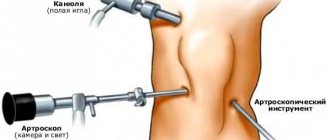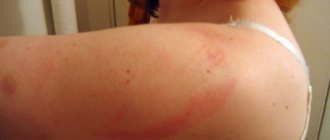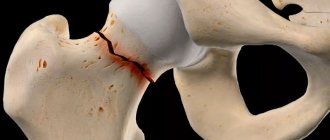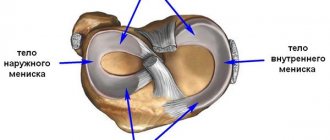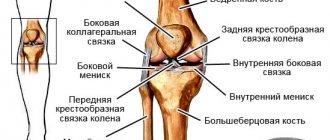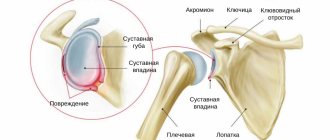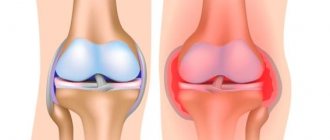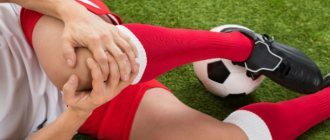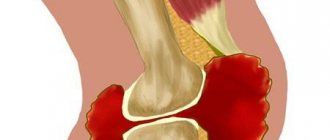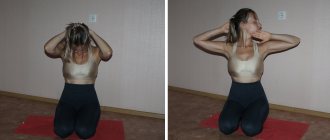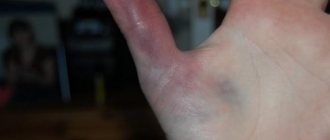Ankle pain is an important symptom when a ligament is torn.
When examining patients with ankle joint injuries, ligament ruptures are diagnosed in 10% of cases. Clinically, injuries are manifested by acute pain in the ankle, the formation of inflammatory edema and hematomas, and limited mobility. The most commonly used methods of conservative treatment are taking medications, performing physiotherapeutic procedures, and exercise therapy. But severe ligament tears require surgery.
Degree of ankle damage
When choosing therapeutic tactics, the determining criterion is the severity of damage to the ankle joint. Depending on the degree of injury, ligament tears are classified as follows:
- 1st degree. Damage is characterized by a slight tear of microscopic fibers, and sometimes of an entire bundle. In everyday life, such injuries are called sprains, which is not true. A ligament is a strong connective tissue cord that does not have any elasticity. Therefore, its fibers do not stretch, but rather tear. Symptoms of grade 1 damage are mild, and range of motion is almost completely preserved;
- 2nd degree. During such an injury, a significant number of ligament fibers are torn. The victim is unable to place full emphasis on the foot due to acute pain, similar in intensity to that which occurs with a fracture of a tubular bone;
- 3rd degree. This is the most severe form of ankle injury, characterized by rupture of most of the fibers or their complete separation from the bone base. The function of the foot of the injured leg is completely impaired. The victim cannot lean on it not only because of severe pain, but also due to a violation of the anatomical structure of the ankle.
Mechanism of ankle ligament rupture.
The ankle joint is fixed by three groups of ligaments - external, internal and tibiofibular. Most often, victims have ruptures of the anterior talofibular external connective tissue cord.
Therapeutic exercise and gymnastics
Exercise therapy is recommended for patients to increase the functional activity of the ligamentous-tendon apparatus. Classes begin with light warm-up exercises. The complex is gradually becoming more complex and supplemented. The general principle of physical therapy is the absence of painful sensations of any intensity. When performing exercises, moderation should be observed:
- prolonged complete rest should not be allowed;
- Excessive loads on the damaged joint should be avoided.
Patients are advised to walk on their toes and then on their heels several times a day. Rehabilitation doctors recommend bending/extending the foot and performing circular rotations for quick recovery.
| Methods for treating injuries | Drugs used, physiotherapy, exercises |
| Pharmacological drugs | Systemic NSAIDs (Celecoxib, Diclofenac, Ketorolac), local NSAIDs (Fastum, Voltaren, Ketorol, Artrosilene), chondroprotectors (Dona, Alflutop, Structum, Teraflex), venotonics (Troxevasin, Lyoton, Heparin ointment), drugs that improve blood circulation (Detralex, Venarus, Phlebodia) |
| Physiotherapeutic procedures | UHF therapy, electrophoresis, paraffin therapy, ultrasound therapy, magnetic therapy |
| Carrying out a surgical operation | Application of tendon and bone sutures |
| Therapeutic exercise and gymnastics | Walking on your toes and heels, picking up small objects from the floor with your toes, rolling a bottle with your feet |
Damage to the ankle ligaments, even grade 1, if left untreated, can cause serious health problems. Over the course of several months, complications develop - flat feet, habitual dislocations, arthritis, arthrosis. Therefore, immediately after injury you need to consult a doctor. Timely examination and proper treatment of ligament rupture will help avoid irreversible consequences.
Possible causes of ligament rupture
Rupture of the ankle ligaments can occur as a result of the foot being turned outward or inward, as well as from a strong direct blow without displacement. The cause of injury is often running, walking on uneven surfaces, wearing high-heeled shoes, and playing active sports, such as athletics, hockey, and football. Ankle injuries are often diagnosed in people who are unprepared for training or those who neglect pre-warm-up. Even at the start, the ligaments cannot withstand intense loads and tear.
Traumatologists identify several factors that provoke this type of joint damage:
- a history of ligament ruptures of any severity;
- obesity;
- professional sports;
An ankle injury in a football player.
- congenital or acquired anomalies of the ankle structure;
- deforming osteoarthritis of the ankle joint;
- flat feet, club feet, dysplasia.
People with hypermobile joints suffer from frequent ligament ruptures in the ankle. They are characterized by the production of special, “superextensible collagen” in the body. The ligaments in such people are not strong, so they are injured even under not too serious loads.
Treatment of torn ankle ligaments at ArthroMedCenter
The course of treatment is 7 or 10 procedures, 1 hour per day. At this time, the patient lies on the device and “receives” the incoming energy without feeling discomfort.
There are special programs lasting 3 days that are used for athletes after intense competitions and training, for people at high risk of developing osteoarthritis, and also to prevent damage to cartilage tissue in rheumatoid arthritis, as well as ankylosing arthritis. Magnetic resonance therapy uses the energy produced by our own hydrogen atoms to heal. In some way, sports injuries are treated with bioenergy, and therefore its use is not associated with consequences for the body and the risk of complications. The procedure can be repeated without restrictions.
Characteristic symptoms
Clinical manifestations are the same for ligament ruptures of any severity. A significant difference is the severity of symptoms. With grade 1 injuries, the patient may not attach importance to minor discomfort in the first hours. Only after some time does stiffness of the joint occur, inflammatory swelling and bruising form on the skin due to rupture of small blood vessels and penetration of blood into the subcutaneous tissue.
| Typical symptoms of grade 2 or 3 ankle ligament rupture | Characteristic features of clinical manifestations |
| Pain syndrome | Intense pain appears at the moment of ligament rupture and is felt for an hour. Then its severity gradually decreases. But as soon as the victim places emphasis on the foot, sharp, piercing pain appears again, making independent movement impossible. It persists for a long time and due to the formation of edema, pressing on sensitive nerve endings |
| Inflammatory edema | After ligament injury, both the lateral and medial surfaces of the ankle quickly swell, but swelling does not form throughout the entire foot or lower leg. The swelling persists for 5-7 days, and then its severity slowly decreases |
| Hematoma | A bruise usually forms during the resorption of swelling. A few days after the injury, it is noted on the entire injured side of the ankle. Then the hematoma moves down to the sole of the foot. Initially, the skin is blue with a purple tint, and then the color changes to greenish-yellow due to the gradual breakdown of blood cells |
| Restriction of movement | In the first days after an ankle injury, the victim cannot move without assistance or crutches, since even touching the foot to the surface causes acute pain |
Swelling and hematoma due to ligament rupture.
Power training
The ankle joint must be strong so that it can support the weight of the body when a person performs daily activities. Strength training is critical, but it is important to follow your doctor's instructions when to begin these workouts. Typically, a person can begin strength training as soon as they can stand without pain.
Grabbing a towel
While sitting on a chair, place a towel on the floor. With your bare feet, use your toes to grab the towel. Hold it for 5 seconds and release. Repeat this action 10 times if it does not cause pain. Another form of this activity is to use the foot to pick up marbles from the ground and place them in a cup.
Exercise with tape
Sit straight on the floor with your legs extended in front of your body. Place the tape around the ball of your foot. Press down on the band so that your toes protrude slightly forward. Repeat this exercise 10 times.
Raising on your toes
Stand behind a chair and place your hands on the back of the chair for support. Place your feet exactly shoulder-width apart and slowly rise up onto your toes and then back down. Try not to feel sorry for the injured party. First, hold onto a chair for support if needed. Do 10-20 of these lifts at once if they do not cause pain.
Which doctor should I contact?
Severe pain and inability to support the foot are signs of grade 2-3 ligament rupture. In this case, it is necessary to call an ambulance to hospitalize the victim in the trauma department. If this is not possible, then you need to take the person to the emergency room yourself. For chronic ankle injuries that have caused a decrease in volume in the joint, you need to make an appointment with a traumatologist.
Depending on the nature of the factors provoking ligament ruptures, treatment may require consultation with a specialist doctor - endocrinologist, orthopedist, rheumatologist. The operation will be performed by an orthopedic surgeon.
Diagnosing problems
The diagnosis is made based on an external examination of the patient, his complaints and the results of instrumental studies. The most informative is radiography performed in frontal and lateral projections. It is carried out to differentiate a ligament rupture from a fracture of a joint or tubular bone.
An experienced diagnostician is able to determine the type of injury after studying the results of ultrasound, despite the fact that it is considered an additional research method. Ultrasound reveals the degree and localization of inflammatory edema, as well as hemorrhage into the joint cavity.
MRI is usually indicated in patients preparing for surgery. The study allows you to outline the surgical field, assess the degree of fiber rupture, and exclude damage to the bone and cartilaginous structures of the ankle.
How to provide first aid to a victim
The speed of restoration of ankle function and the intensity of symptoms depend on how quickly and efficiently first aid is provided. The victim is placed on a hard surface, covered with a thin blanket or rug, and calmed down. Provide complete rest to the damaged joint, fix the leg with a splint or bandage in a slightly elevated position.
Then use cold, applying cold compresses to reduce the intensity of pain. A plastic bag filled with ice cubes is applied to the ankle for 10 minutes every half hour. A piece of frozen meat, a mixed vegetable, or a towel soaked in cold water will also work. Cold compresses not only have an analgesic effect, but also prevent the formation of inflammatory edema as a result of narrowing of small blood vessels.
The victim is given a tablet of any non-steroidal anti-inflammatory drug (NSAID). These are Diclofenac, Nise (Nimesulide), Ketorol (Ketorolac). If there are no such drugs in your home medicine cabinet, then use Paracetamol. Until the ambulance team arrives, such drugs will provide an analgesic effect.
Flexibility
Improving ankle flexibility helps the ankle move and stretch as needed to support body weight. There are a number of exercises aimed at increasing flexibility in the ankle joint.
Calf stretch
- Stretching the muscles with a towel, band, or other object can increase flexibility.
- Sit on the floor with your legs straight out in front of you.
- Place a towel or tape around the balls of your feet and gently pull your feet back so your toes point toward your body.
- Do this without bending your knees, which should cause a slight stretch in your calf muscles and the back of your leg.
- Hold the stretch for 30 seconds if it does not cause pain.
Standing calf stretch
- Place your hands on the wall at approximately eye level.
- Take a small step back with your affected leg.
- Keeping your leg flat on the floor, gently bend your other leg at the knee, feeling a stretch in your calf. Hold for 30 seconds.
- After that, repeat the same action, but this time bend your knee slightly. This will stretch the other part of the calf. Hold for 30 seconds.
- Repeat this exercise three times.
Treatment methods
In case of ruptures of the ankle ligaments of 1st and 2nd severity, treatment is carried out at home with the obligatory observance of a gentle regimen. It is forbidden to subject the injured leg to any stress - standing for a long time or moving long distances. During the first 3 days of treatment, cold compresses are used every hour for 10-15 minutes.
Immobilization and fixation
In case of significant ligament ruptures, a plaster splint is placed on the leg for up to 7 days. Wearing it for a longer period of time is prohibited, as it leads to instability of the ankle joint.
Plaster splint.
This orthopedic device reliably immobilizes the lower limb and prevents the displacement of damaged fibers. But with prolonged wearing of a plaster splint, the likelihood of weakening muscles and excessively slow regeneration of ligaments increases.
Rigid or semi-rigid orthoses are also used to stabilize the ankle. They are more convenient to use, and some models are equipped with special inserts to prevent muscle atrophy.
A grade 1 rupture does not require strong fixation of the limb. Patients are advised to wear elastic bandages during the daytime. Such devices only slightly limit mobility, preventing excessive loads on the ankle.
Fixation of the ankle in case of injury.
Drug therapy
To eliminate acute pain syndrome observed in the first hours after injury, NSAIDs are used in the form of parenteral solutions: Ortofen, Xefocam, Movalis. The drugs have a complex effect on the injured ankle - they relieve inflammation, relieve pain, and reduce local temperature. Then NSAIDs in tablets are included in therapeutic regimens:
- Ibuprofen;
- Celecoxib;
- Etoricoxib;
- Nimesulide;
- Ketoprofen.
Mild discomfort can be relieved by local application of NSAID gels and ointments to the ankle. These are Voltaren, Fastum, Finalgel, Artrosilen, Dolgit.
External products with a combined composition - Dolobene, Indovazin - have also proven themselves well. Approximately on the 3-4th day of therapy, after the inflammatory edema has subsided, cold compresses are canceled. Now patients are prescribed ointments with a warming and local irritating effect: Finalgon, Capsicam, Viprosal. To eliminate extensive hematomas, venoprotectors for external use are used: Lyoton, Troxevasin or its domestic structural analogue Troxerutin.
Physiotherapeutic treatment
On the 2-3rd day of treatment, the clinical effectiveness of the drugs is increased through physiotherapeutic procedures. They are also actively used at the stage of rehabilitation after surgery.
For ligament ruptures of moderate and severe severity, manifested by severe pain, patients are prescribed electrophoresis or ultraphonophoresis with anesthetics, analgesics, B vitamins, and calcium solutions. Under the influence of electric current or ultrasound, drug molecules are delivered directly to the injured ligaments, rather than being carried by the bloodstream throughout the body. During the recovery period, these procedures are carried out with chondroprotectors - drugs that stimulate the rapid regeneration of connective tissue structures.
At the rehabilitation stage, patients are also recommended the following physiotherapeutic measures:
- UHF therapy;
- magnetic therapy;
- galvanic currents;
- laser therapy.
Magnetic therapy for ruptured ankle ligaments.
To improve blood circulation and microcirculation, applications (layer-by-layer application) of paraffin or ozokerite are used. Balneotherapy, hirudotherapy, acupuncture, and manual therapy are used.
Exercise therapy
Even at the stage of wearing a plaster splint or a rigid orthosis, which reliably immobilizes the ankle, patients are advised to undergo daily physical therapy exercises. During this period, it is possible to perform static movements - alternately tensing and relaxing the muscles of the injured leg. They help improve blood supply to injured ligaments, accelerate their regeneration, and prevent muscle atrophy.
The physical therapy doctor will create a set of exercises taking into account the severity of the injury and the patient’s physical fitness. Regular training significantly reduces the duration of rehabilitation and allows you to quickly return to your normal lifestyle. The following exercises are usually included in the treatment complex:
- walking first on your toes, then on your heels;
- jumping rope;
- rolling a bottle with your foot on the floor surface;
- circular rotations of the foot;
- flexion and extension of the ankle.
These trainings, depending on the degree of rupture of the ligament fibers, begin 1-3 months after the injury. Exercise therapy doctors also recommend swimming, water aerobics, Pilates, and Nordic walking.
Traditional methods of treatment
It is not advisable to use folk remedies in the treatment of ankle ligament ruptures due to the risk of improper fusion of the fibers. The only exception is infusions of medicinal herbs. Herbal teas made from elecampane, chamomile, and calendula are especially in demand for injuries to the musculoskeletal system. Their use stimulates the acceleration of metabolism and the removal of tissue breakdown products.
Ankle baths.
Traumatologists sometimes include infusions of oregano, lemon balm, St. John's wort, motherwort, and valerian in treatment regimens to improve the psycho-emotional state of patients and normalize sleep. To prepare them, pour a teaspoon of dry plant material into a glass of boiling water and leave for an hour. Then filter and take 100 ml 2-3 times a day after meals.
Balance
- The feet are also critical to balance.
- Exercises to help strengthen and maintain balance:
Balancing one leg
- While standing behind a chair, place your hands on the back of the chair for support.
- Raise your healthy leg so that your affected leg bears the weight of your body. Make sure your knee is slightly bent and balanced for 30 seconds.
- Use a chair for support at first, but it is important to perform this exercise with little or no support. This will increase your overall ankle strength.
Once a person has mastered this skill, they can move on to more advanced balance exercises. Variations may include balancing on the affected leg while:
- you move your head from side to side
- slightly bend and straighten your knee
- keep your eyes closed
These exercises are difficult to do, but they can help train your leg to improve your balance.
Unacceptable mistakes in the treatment of pathology
It is strictly forbidden to use dry or damp heat at the beginning of treatment, especially when providing first aid. The use of heating pads, products with a warming effect, including alcohol rubbing, will cause progression of the inflammatory process and increased pain.
Massage and dynamic exercises are indicated only after the main treatment. You cannot work on ligaments that have not yet fully recovered, overcoming pain.
Ankle massage is allowed only after the function of the joint has been restored.
First aid
Injuries that occur when the foot rolls in are mistakenly called sprains. However, they do not stretch, otherwise swelling and hematomas would not occur in the ankle area. When injured, partial or complete ruptures of the ligaments occur. A sprain is a violation of the integrity of individual fibers, but the functional activity of the ankle is preserved.
If the ligament is damaged, the victim must be given first aid. At the initial stage of treatment, any stress on the ankle is excluded. This will help prevent further injury to the ligaments and tendons of the ankle muscles. What else can you do to help the victim:
- cold compresses. Their use helps prevent the spread of edema and hematoma to healthy tissue. And the resulting feeling of numbness relieves pain of varying intensity. Applying a compress immediately after an injury shortens the duration of treatment. For the procedure, you can use ice cubes, frozen pieces of meat or a bag of mixed vegetables. They are wrapped in cloth and applied to the ankle for 20-25 minutes. The next exposure is carried out only after 1-2 hours to prevent frostbite;
- fixing bandages. An elastic bandage can be used to immobilize the joint. When applying a bandage, moderation should be observed. Tight bandaging will cause numbness in the toes and an increase in the intensity of swelling. An elastic bandage will prevent further tears by limiting movements;
- elevated position. The injured leg should be in an elevated position. It can be placed on 1-2 pillows, and while sitting - on a stool. This will help eliminate ankle pain and swelling of the periarticular tissues.
When providing first aid, any thermal procedures, including the application of warming ointments, are strictly prohibited. You cannot rub your ankle with alcohol, vodka, or take a hot bath. Traumatologists recommend removing the elastic bandage before going to bed.
If the victim refuses to go to the hospital, then his condition must be monitored within 24 hours. If swelling and hematoma spread, pain intensifies, hospitalization should be insisted on. Signs of sprained ligaments are similar to the clinical manifestations of ankle sprains and fractures. And such injuries require urgent medical intervention.
